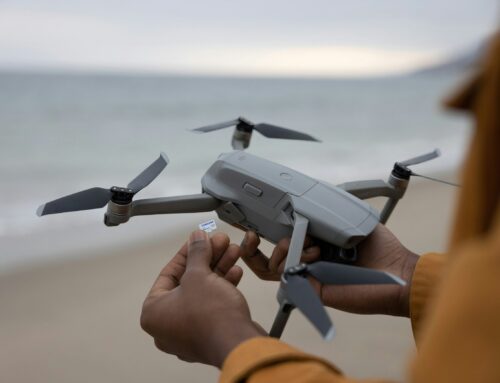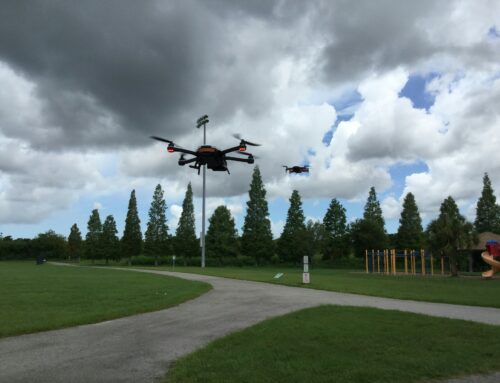Teledyne FLIR is ending sales of its SIRAS inspection drone – a surprising move that has caught many offguard. By August 31, 2025, you won’t be able to buy a new SIRAS directly from the company. And while existing users will still get support for a couple more years, this decision marks a major shift in strategy for one of the drone industry’s biggest sensor providers. Why would a company known for thermal imaging excellence abruptly stop selling a drone that was launched with much promise in 2022? What does it mean for industrial inspectors, first responders, and you?.
The Rise of SIRAS: An American Inspection Drone
SIRAS hasn’t been around for long – Teledyne FLIR first launched the SIRAS drone in September 2022.
In the short time since, this drone has made a name for itself in critical missions for public safety and industrial inspection. But what exactly is SIRAS, and why did it matter? Simply put, SIRAS was Teledyne FLIR’s bid to offer a professional-grade drone that combined the company’s famed thermal imaging tech with a reliable, user-friendly airframe. It was built to tackle tough jobs: inspecting power lines and solar farms, scouting for wildfires, helping police and firefighters in emergencies – you name it.
From the get-go, SIRAS was marketed as a secure, high-performance drone designed to address American agencies’ concerns about foreign-made drones. It’s no secret that many off-the-shelf drones (you might be thinking of a certain popular brand from abroad) raised red flags over data security. SIRAS was different. It stores all images and videos locally on a microSD card with no cloud connection and no required online account, so your sensitive inspection footage stays in your hands. And to really drive home the point: the aircraft is manufactured in Taiwan, while its advanced camera payload is made in California, USA. In other words, SIRAS was built to avoid any “countries of concern” in its supply chain, easing the minds of government users worried about spying or backdoors.
Security aside, SIRAS also came ready to work. This drone is IP-54 rated for dust and water resistance – tough enough for rainy nights and gritty construction sites. It can fly for over 30 minutes per battery and even has hot-swappable batteries to minimize downtime. With a radar-based collision avoidance system in the front, it’s less likely to crash into obstacles during an inspection. And unlike some drones that might lock you out of takeoff near airports or critical infrastructure, SIRAS has no geofencing. You’re in control of where and when to fly, which is crucial when an emergency can’t wait.
The drone is also relatively portable – you can pack it in a backpack – so field teams could easily carry it to remote sites.
Packed with Thermal Vision Power
Of course, being a FLIR product, the star of the show was the imaging system. SIRAS carries a dual-sensor gimbal featuring a visible camera and a thermal camera. The visible camera packs 16 megapixels and an impressive 128× zoom to spot fine details from afar. The thermal side uses FLIR’s renowned Boson core – specifically a 640×512 pixel radiometric Boson that can measure the temperature of every pixel in view.
So SIRAS could not only show you a heat signature, but tell you exactly how hot that electrical transformer or rooftop solar panel is, from a safe distance. With a 5× digital zoom on the thermal camera plus FLIR’s special image enhancement (known as MSX) layering thermal and visual details, the drone delivered clear thermal imagery even in total darkness.
In one dramatic night operation, a sheriff’s department in Nebraska used a SIRAS to track down an armed suspect hiding in a field. The SIRAS’s thermal camera spotted the fugitive in pitch darkness among thick weeds, a task that would have been nearly impossible otherwise. Deputies on the scene said the drone “saved us tons of time” and kept officers out of harm’s way. They didn’t have to wander blindly in the dark or wait hours for daylight – the drone did the dangerous scouting in minutes. For that team, SIRAS was a “force multiplier,” allowing a swift resolution to a high-risk situation.
Public safety agencies weren’t the only ones interested. Utility companies and industrial inspectors saw the appeal of SIRAS too. Say you need to inspect a high-voltage transmission line or a refinery pipeline. With SIRAS, you could fly up close, detect heat anomalies indicating potential issues, and do it all without shutting down operations or putting a person in a risky spot. Its dual cameras meant you could capture a normal image and a thermal image in one flight, giving a complete picture of asset health. And because there’s no geofence, even sensitive facilities could be inspected without begging a foreign app for permission. For a while, it seemed SIRAS was poised to carve out a solid niche as the go-to American-made (or at least American-supported) inspection drone for those who valued security alongside performance.
A Promising Start – So What Went Wrong?
Given all these positives, you might be wondering: if SIRAS was so capable, why is Teledyne FLIR pulling the plug on sales? It’s a good question, and it doesn’t necessarily have a simple answer. There wasn’t a public fiasco or a recall; in fact, the drone received plenty of positive feedback from users according to the company. SIRAS proved its worth in the field, and customers seemed to like it. Yet here we are – sales ending barely three years after launch.
One clue lies in how aggressively Teledyne FLIR tried to push SIRAS in the market. By late 2024, they were running steep promotions – offering SIRAS at a 28% discount for first responder agencies. The drone that originally listed for around $9,700 was marked down to $6,995 for police, fire, and search-and-rescue departments. That’s a big price cut. Teledyne FLIR even teamed up with grant programs to help public safety teams afford the drone, signaling that they really wanted to get SIRAS into more hands. The company said they wanted to support the community because of the agencies’ mission and limited budgets. A Teledyne FLIR vice president added that many agencies were looking for alternatives to drones made in countries of concern, hinting at the dominance of Chinese-made drones. SIRAS was positioned as that alternative, and Teledyne FLIR was sweetening the deal to grow its user base.
Despite these efforts, it appears SIRAS didn’t gain the market share the company hoped for. By mid-2025, Teledyne FLIR made the tough call to stop selling it entirely. The official reasoning isn’t “SIRAS failed” – instead, the company frames it as a strategic pivot (we’ll dig into that next). But reading between the lines, it’s likely that competing in the drone business is an uphill battle, even for a respected player like FLIR. The drone industry is fiercely competitive, and manufacturing a drone platform – sourcing parts, keeping up with rapid tech advances, and scaling production – is a whole different ballgame than making cameras.
Consider the landscape: on one side you have the giant overseas manufacturers with economies of scale and slick integrated products. On the other, a handful of U.S. and allied manufacturers are trying to catch up, often with higher prices or smaller ecosystems. SIRAS entered this arena as a newcomer. While it offered unique security and thermal capabilities, many enterprise drone buyers had already invested in other platforms or were waiting for U.S.-made options to mature further.
In short, SIRAS had a lot of competition and not a lot of time to prove itself. By offering big discounts in 2024, Teledyne FLIR signaled that widespread adoption wasn’t there yet – they were trying to jump-start demand. It may not have been enough.
Why Teledyne FLIR Is Ending SIRAS Sales (In Their Own Words)
Now, let’s look at the official explanation from Teledyne FLIR. The company isn’t saying SIRAS was a flop; they’re saying this move is about focusing on what they do best. According to the announcement, Teledyne FLIR OEM will discontinue SIRAS sales to concentrate on their “core strengths: next-generation thermal infrared imaging technologies and embedded decision-support software.”In other words, they want to double down on making superior thermal cameras and the software that powers them, rather than building complete drones for the commercial market. This is a strategic shift more than anything.
Paul Clayton, Vice President and GM of Teledyne FLIR’s OEM division, put a positive spin on the news when thanking customers: “Your trust and collaboration have been instrumental in the success of this platform,” he said, emphasizing that FLIR is grateful for the support SIRAS received. It’s a nice way of saying sorry we won’t be selling this drone anymore, while assuring folks that the platform did have successes. The company also highlighted that they’ve gotten great feedback on SIRAS – so the decision isn’t due to quality issues or customer dissatisfaction.
So why step away from selling it? Teledyne FLIR explains that by refocusing, they can “deliver greater innovation and value to life-saving missions and critical operations” through their thermal tech and software. Essentially, they see more bang for their buck (and a bigger benefit to their customers) by being the brains and eyes inside many drones, rather than selling one branded drone of their own. It’s like a car engine manufacturer deciding to stop making an entire car model so they can sell their engines to all the other car makers.
From a business perspective, this refocus makes sense. Teledyne FLIR (formerly just FLIR Systems) built its reputation over decades as the world leader in thermal imaging and infrared cameras. They’ve supplied cameras for everything from military aircraft to smartphones. In 2021, FLIR was acquired by Teledyne Technologies in a deal worth about $8.2 billion, creating the Teledyne FLIR we know today. That’s a huge investment, and it underscores how valuable FLIR’s core technology is. Thermal cameras are used in defense, surveillance, industrial automation, automotive safety, and more – markets that are growing and evolving rapidly. By some estimates, the global thermal imaging market is expected to increase from $6.5 billion now to $9.1 billion by 2029, propelled by new uses in cars and even wearable devices. Teledyne FLIR clearly wants a big piece of that expanding pie.
Back to Basics: Teledyne FLIR’s New (Old) Strategy
So what does Teledyne FLIR’s strategy look like post-SIRAS? In a nutshell: be the expert behind the scenes. The company is going back to what it has always done well – making the high-tech components that other platforms need. That means focusing on their thermal camera modules, sensors, and the software algorithms that make sense of thermal data. FLIR isn’t exiting the drone world entirely; far from it. They’re just changing how they participate in it.
Teledyne FLIR proudly states that their “industry-leading thermal camera modules will continue to be integrated into platforms from other drone manufacturers. If you’re flying a Skydio drone for public safety or a Red Cat (Teal) drone for defense, there’s a good chance it carries a FLIR thermal camera inside. FLIR’s announcement explicitly name-dropped Skydio, Red Cat, AerialOGI, and others as partners using its technology. For you, as an end user, that means you’ll still benefit from FLIR’s thermal vision when you use those drones – even if the drone doesn’t have a FLIR logo on the outside. In fact, FLIR’s retreat from selling its own general-purpose drone might lead to even better cameras and sensors coming out for all drone makers, since the company can pour all its energy into R&D for imaging tech.
There’s also the defense side to consider. Teledyne FLIR isn’t abandoning drone hardware entirely – they’re just leaving the broad commercial market. On the military and specialized end, Teledyne FLIR Defense will continue to produce advanced drone airframes, including their famous SkyRanger and Black Hornet drones. SkyRanger is a rugged military-grade quadcopter used for reconnaissance (originating from FLIR’s acquisition of Aeryon Labs), and Black Hornet is a tiny palm-sized nano-drone used by soldiers to scout buildings and battlefields. These are niche, high-end systems that FLIR (now Teledyne FLIR Defense) has years of experience with. The company even mentioned new models like Rogue™ and SkyRaider™ continuing under its defense portfolio. So, for defense and government clients, FLIR is still very much in the drone airframe business. But for the rest of the market – the utilities, firefighters, and commercial inspectors – FLIR is choosing to supply the technology rather than the whole drone.
From a strategic viewpoint, this is FLIR recognizing where it has its strengths. Few companies can rival FLIR in thermal imaging tech. (After all, FLIR literally stands for Forward-Looking Infrared – this is their DNA.) By focusing on sensors and letting other companies handle the flight platforms, FLIR can ensure its thermal cameras are everywhere – on many drones instead of just their own drone – and even beyond drones. Remember they also mentioned focusing on “embedded decision-support software”. That implies FLIR is working on the brains to interpret thermal data using AI and analytics. Think automatic target detection, AI that can spot a gas leak in a refinery via the thermal camera, or driver assistance systems in cars that use thermal vision to detect pedestrians at night. These are high-growth areas, and FLIR wants to be the top player there.
In practical terms, ending SIRAS sales is a course correction. Teledyne FLIR is saying: we tried being a drone manufacturer in the wider market, but our true calling is to be the indispensable supplier of the tech that makes drones (and other machines) smart and perceptive. Like what you get when a star athlete decides to switch positions to where they can contribute more. It’s a bold move – and not everyone in the industry saw it coming – but it plays to FLIR’s strengths.
Support for Existing SIRAS Users – You’re Not Left Hanging
If you already have a SIRAS drone or were thinking of getting one (perhaps grabbing a unit from a distributor before they’re gone), you might be concerned about support. The good news is Teledyne FLIR isn’t leaving current customers high and dry. They’ve committed to continuing support, warranty service, repairs, and parts for SIRAS through September 30, 2027. That’s a full two years beyond the end-of-sale date. In an age when some tech companies kill a product and cut off support almost immediately, a two-year support window is relatively generous.
What does that support include exactly? According to FLIR’s end-of-life FAQ, you’ll still get warranty services, technical assistance, and access to replacement parts and batteries (as available) during that period. They even plan to release any firmware and software updates that were already in development for SIRAS, and they might issue critical fixes if something urgent comes up, all the way until the end of support in 2027. In short, if you own a SIRAS, it’s not going to become a paperweight anytime soon. You can keep flying it for years and know the manufacturer has your back for maintenance and troubleshooting.
Teledyne FLIR is also being proactive about helping customers transition. They’ve said they will assist with planning replacement solutions. That might mean advising agencies on other drones that could fill SIRAS’s shoes. While FLIR won’t be selling a direct successor to SIRAS – they’ve confirmed there’s no new drone model planned to replace it – they acknowledge that users will eventually need alternatives. In their FAQ, they gently point to the fact that FLIR’s thermal modules live on in other drones by partners and that their defense division’s drones (like SkyRanger or Black Hornet) are still options for those who need high-end solutions. For example, if you loved SIRAS mainly for its thermal imaging, you might look at a Skydio X2 with a FLIR thermal camera, or a similar US-made drone that meets your needs. FLIR essentially says: we’re not selling you a drone anymore, but we’ll make sure the other drones you buy have our technology inside.
The company has also clarified that this move doesn’t affect any of their other products – it’s isolated to the SIRAS drone. So, if you use FLIR handheld thermal cameras, security systems, or other gear, rest assured those are continuing as usual. Teledyne FLIR isn’t downsizing or in trouble; they explicitly stated they’re growing and this decision doesn’t impact staffing levels. That’s an important point: sometimes when a product line ends, people worry the company is hitting hard times. But in this case, FLIR is emphasizing the opposite – they’re doing well and want to realign resources for even bigger things.
What It Means for the Drone Industry and the Market
Teledyne FLIR’s choice to end SIRAS sales is also a signal about the drone industry’s direction, especially in the U.S. For one, it highlights just how challenging the drone hardware market can be, even for established players with deep pockets. FLIR invested in drones over the past several years – they acquired multiple drone companies like Altavian in 2020 to bolster their capabilities. They clearly had ambitions to offer complete UAS solutions, and SIRAS was a culmination of those efforts for the commercial sector. The fact that they’re stepping back now suggests that being a drone manufacturer wasn’t yielding the returns or market penetration they wanted. It’s a reminder that the dominance of certain big drone makers is hard to chip away at.
For American and allied drone manufacturers, FLIR’s exit from direct competition could be a double-edged sword. On one hand, one less American-made drone option in the market might seem like a setback for the push to diversify away from foreign systems. Agencies looking for NDAA-compliant, secure drones had SIRAS on their list; now that list is shorter. This could concentrate more demand on the remaining players (like Skydio, or the drones from Red Cat’s Teal), potentially giving them more opportunity to grow. On the other hand, less competition can also slow innovation – but in this case, FLIR’s not leaving the scene entirely. Instead of competing by selling a drone, they’ll compete by making better components for everyone’s drones. In theory, that could accelerate innovation in thermal imaging across the board. Smaller drone companies that don’t have the resources to develop advanced sensors may benefit from FLIR’s intense focus on new imaging tech and AI.
Another implication is the maturing understanding that specialization matters in tech. Teledyne FLIR deciding to be the “intel inside” for drones (and other systems) rather than the one selling you the finished drone shows a strategic specialization. It’s acknowledging that to build world-class drones, you need world-class flight autonomy, manufacturing, distribution, etc., and world-class sensors. FLIR is choosing to be the world-class sensor and leave the rest to others. We may see more of this kind of collaboration in the industry: companies teaming up, each contributing their best piece of the puzzle, rather than everyone trying to do it end-to-end. For you as a user, that means future drones might come with a pedigree: the best camera from one company, the best airframe from another, and the best software from yet another, all integrated.
From the market standpoint, demand for drone-based inspection and public safety solutions is still rising. Energy utilities, construction firms, police and fire departments – they all are increasing their drone usage for efficiency and safety. Teledyne FLIR bowing out of selling SIRAS doesn’t change that demand; it just means others will fill the supply. You might see more thermal camera options on competitor drones, possibly even licensing of FLIR’s technology to third parties. And don’t forget, FLIR’s parent company Teledyne has a broad portfolio in sensors and imaging. They might integrate thermal sensors with other technologies (like high-res optical cameras, gas detection sensors, etc.) to create new payloads that can mount on various drone platforms. The end of SIRAS could indirectly spark new innovations in multi-sensor payloads that benefit the inspection market.
If you were an early adopter of SIRAS for industrial inspections, you proved the value of having a secure, thermal-capable drone. That value isn’t lost – if anything, FLIR’s commitment to next-gen thermal systems means when you go to buy your next inspection drone in a few years, you’ll likely find an even better FLIR camera on it.
It’s a trade-off: we lose a unique all-in-one drone offering now, but potentially gain stronger tech integration in the near future.
The End of SIRAS Marks a New Chapter
The decision by Teledyne FLIR to end sales of its SIRAS drone is a big deal, but it’s not a death knell for FLIR’s presence in the skies – far from it. Think of it as a pivot. The company is doubling down on what it does best (thermal imaging and smart sensing) and stepping back from what others can do better (building and marketing entire drones). For current SIRAS users, support continues for a couple more years, so you can keep flying with confidence knowing FLIR has got you covered on parts and service. For the industry, this move frees Teledyne FLIR to pour its expertise into the next generation of sensors that will power countless drones and other devices.
Yes, it’s a bit sad to see an American-born drone like SIRAS reach an early end. It had become a trusted tool for many – from helping firefighters see through smoke to letting engineers inspect a cell tower without climbing. But its spirit isn’t disappearing. The technology and lessons of SIRAS will live on in the thermal cameras and software FLIR brings to the table for other platforms. The company has reaffirmed that it’s not leaving the drone arena, but “growing and refocusing” on the tech that makes drones effective. In plain terms, you’ll still see FLIR’s thermal eyes in the sky whenever a police drone finds a missing person at night or a utility drone spots a failing solar panel.
For you as an observer or user of drone technology, the takeaway is this: you might not be buying a “Teledyne FLIR SIRAS 2” any time soon, but the next drone you do buy could very well have FLIR’s fingerprint on it – through a sensor or software that makes it far more capable. Teledyne FLIR’s shift is a reminder that sometimes companies make bold choices to ensure they continue leading in innovation. It might shake things up in the short term (and certainly, some SIRAS fans are disappointed), but it’s aimed at bigger long-term gains.
In the ever-evolving drone industry, adaptability is key. Teledyne FLIR is adapting – betting that by focusing on core technologies, they can have a hand in a broader swath of the market than they did with one drone model. Only time will tell how successful this strategy will be, but to be clear: FLIR’s thermal technology isn’t going anywhere. So next time you’re out on a mission – whether you’re an inspector checking a pipeline or a first responder searching for a lost hiker – and your drone helps you “see the unseen,” there’s a good chance you’ll have Teledyne FLIR to thank for that, even if the drone itself doesn’t say SIRAS on the side.





